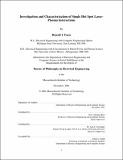Investigation and Characterization of Single Hot Spot Laser-Plasma Interactions
Author(s)
Focia, Ronald J.
DownloadRonald J. Focia TR712.pdf (4.205Mb)
Metadata
Show full item recordAbstract
Control of parametric laser-plasma interactions (LPI) is essential to the success of inertial
confinement fusion (ICF). Through a research collaboration with the Los Alamos National Laboratory
(LANL), we have had the opportunity to participate in world-class laser-plasma experiments. The goal of
these experiments was to gain a fundamental understanding of LPI by studying the interaction of a single
laser hot spot, or speckle, with a preformed, quasi-homogeneous, long scale-length plasma. Recent single
hot spot experiments resulted in a wealth of data and the first definitive observation of two LPIs. Namely,
the Langmuir decay instability (LDI) cascade and stimulated scattering off of an acoustic-like electron
mode below the usual electron plasma wave frequency.
The LDI is the result of the electron plasma wave (EPW) generated by stimulated Raman
scattering (SRS) growing to a sufficient amplitude such that it exceeds a threshold (proportional to the
damping of the LDI daughter waves) and undergoes parametric decay into another counter-propagating
EPW and a co-propagating ion acoustic wave (IAW). Subsequent EPW decays due to LDI are possible and
collectively more than one EPW generated by LDI is called LDI cascade. The LDI cascade can play a role
in the saturation of SRS since wave energy from the SRS EPW couples into secondary waves that are nonresonant
with the SRS process.
Stimulated scattering from an electrostatic wave at a frequency and phase velocity ( ω ≈0.4 ωpe,
v φ≈1.4ve) between that of an EPW and IAW was also observed. In this thesis, a Vlasov-Maxwell code is
used to numerically predict the time evolution of the electron distribution function for the experimental
parameters. The resultant distribution function is then modeled as a bi-Maxwellian (one background and
one beaming) to show that it exhibits linear modes that include the observed electron acoustic wave. A
quasimode analysis of laser scattering off of this linear mode is presented as one possible explanation of the
experimental observation.
Description
Prof. Abraham Bers, Professor of Electrical Engineering and Computer Science
Dr. Juan C. Fernández, Deputy Group Leader of P-24, LANL (Co-Supervisor)
Date issued
2006-06-28Series/Report no.
Technical Report (Massachusetts Institute of Technology, Research Laboratory of Electronics);712